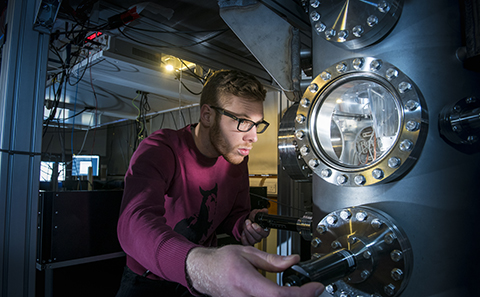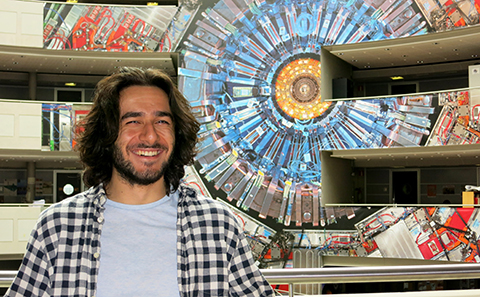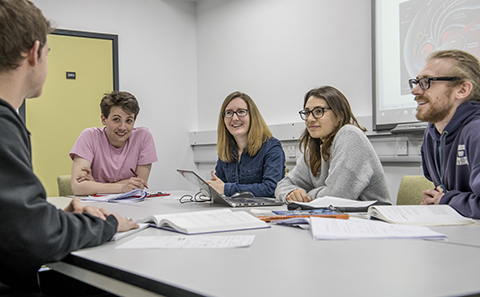
Your typical week
What will your week be like as a physics student at Southampton?
Course |
UCAS Code |
Duration |
| BSc Physics | F300 | Three Years |
| MPhys Physics | F303 | Four Years |
| MPhys Physics with Astronomy | F3FM | Four Years |
| MPhys Physics with Space Science | F3FX | Four Years |
| MPhys Physics with Mathematics | F3GC | Four Years |
| MPhys Physics with Photonics | F369 | Four Years |
| MPhys with with Nanotechnology | F390 | Four Years |
| MMath Mathematical Physics | FF34 | Four Years |
| MPhys Astrophysics with a Year Abroad | Enter via F3FM | Four Years |
| MPhys Particle Physics with a Research Year Abroad | Enter via F303 | Four Years |
| MPhys Physics with a Year of Experimental Research | Enter via F303 | Four Years |
| MPhys Physics with Industrial Placement | Enter via F303 | Four Years |

What will your week be like as a physics student at Southampton?

Our students have the opportunity to study at CERN and the Harvard-Smithsonian Center for Astrophysics.

Our students share their thoughts and experiences of studying physics at Southampton.
3rd year student Sai tells us about his experience studying Physics and Astronomy at the University of Southampton.
Calling all budding artists with an interest in physics and astronomy.
As part of the University of Southampton's Sciences and Engineering Festival (SOTSEF) Goes Digital, children and adults around the world are being challenged to create a piece of art inspired by their research into astrophysics.
The #SotonAstroArt competition is being run by the Physics and Astronomy team for people of all ages to submit their artwork reflecting 'The Life Cycle of Stars, Supernova and Dark Energy'.
Artwork can take on any form and participants can get their ideas from exploring Southampton's exciting Physics and Astronomy research, as well from other astrophysics research, including:
Competition organiser Dr Sadie Jones, Astronomy Public Engagement Leader, said: "In our past art workshops I have been amazed at how the combination of both learning about astronomy and creating art makes people so excited. Some people sit and make art with us for hours.
"My hope is that this competition creates an opportunity for people to make art at home, during lockdown, to find some calm and learn something about stars they didn't already know. They might even feel a little bit more connected to the life cycle of a star, because we are indeed all made of star stuff!"
You can get further inspiration for your artistic creations from examples of work that has been created in previous #SotonAstroArt workshops and watch how Sadie made her own piece of art.
The competition is open to participants around the world and there are four age categories:
First prize for each age category is a professional art set, a Hoberman sphere and glow in the dark planets, while second and third prize winners will receive glow in the dark planets. All winners will also get the chance to exhibit their artwork at the next #SotonAstroArt exhibition.
The deadline for entries is 5pm on July 25, 2020. Photos of artwork should be sent to physwizz@soton.ac.uk or uploaded to SotonAstroArt. Make sure you put the age category you are entering and your town and country locations eg. Southampton, UK.
A Southampton Astronomer has been awarded Global Challenge Research Fund (GCRF) money to boost his work with Nigerian doctors to manage high blood pressure among the population of low- and middle-income countries (LMICs).
Associate Professor in Physics and Astronomy, Dr Francesco Shankar, is developing a smart algorithm for optimising hypertension management strategies. He is exploiting a common technique used in extra-galactic astronomy to assist clinical decision making in blood pressure treatments.
Francesco is already exploring this field of research as a Fellow of the prestigious Alan Turing Institute, the UK's national institute for data science and artificial intelligence, and this new funding will allow him to expand this work into the new project comparing different strategies for the management of hypertension in LMICs.
He said: "Hypertension is a major cause of morbidity and mortality globally. Despite growing awareness of the condition, the global prevalence is increasing with the most rapid rise recorded in LMICs. Therefore, there is an urgent need for novel approaches to improve blood pressure control and to reduce the detrimental economic and societal impact of preventable cardiovascular events.
"Our solution is to identify ways in which hypertension management can be simplified, which we aim to achieve by integrating patient data into our existing model of hypertension management. This data will enable us to predict which novel approaches are most likely to be beneficial to sub-Saharan populations."
The £57,000 money has been awarded from the GCRF – a £1.5b fund announced by the UK Government to address complex global development challenges and support collaborative research that will improve the economic prosperity, welfare and quality of life of people in LMICs.
Francesco said: “We have already been collaborating with the Department of Clinical Pharmacology at St Thomas’ Hospital, in London, to develop a cutting-edge Bayesian Hierarchical Monte Carlo (BHM) model that can probe the complexities of blood pressure management within large populations.
"This approach has yielded novel findings about how blood pressure measurement techniques and drug selection can influence blood pressure control within a population, and consequently the incidence of cardiovascular events such as heart attacks or strokes.
"This GCRF funding will enable us to develop that further, in collaboration with Nigerian doctors, by employing a research software engineer to provide valuable insight and experience into generating a new branch of our model specifically tuned to tackling the Nigerian populations and general patients from LMICs.
"The software engineer will also be able to promote our results in the UK and globally through online training and workshops, while ensuring that the software is developed sustainably, is testable, reproducible, well-documented and interoperable."
A Southampton Physics and Astronomy graduate has received global recognition for his thesis with the award of an international prize.
Peter Boorman, who completed his PhD studying supermassive black holes, has won the Springer Theses accolade which is given to the best PhD theses from around the world.
The Springer Theses recognise the work of PhD students by collecting and publishing the best PhD theses from around the world in all physical sciences.
The winners get the opportunity to publish a book - containing their full thesis - with an international publisher, which helps them gain recognition for their research early in their career.
Internationally top-ranked universities nominate their best theses in chemistry, physics, Earth sciences, engineering and materials science from the last year, and the winners are chosen for their scientific excellence and wide impact.
Peter's thesis focused on his research into the supermassive black holes located at the centre of galaxies outside the Milky Way - some of the most extreme systems that exist in nature. These black holes are capable of emitting light across the full electromagnetic spectrum and are the only opportunity for people to probe such experiments on Earth.
He said: "These systems are very challenging to study, so I use NASA’s X-ray facility - the Nuclear Spectroscopic Telescope ARay (NuSTAR) - that greatly enhances my ability to explore the most obscured growing supermassive black holes in our cosmic neighbourhood. I have already discovered a large population of heavily obscured active galactic nuclei (AGN) that have never been observed or detected previously.
"I am delighted to have been awarded the Springer Theses, when I first found out I couldn’t believe it. My experience writing up my thesis was quite stressful both personally and academically, so I am thrilled to receive recognition for it. I would also like to thank my supervisor Dr Poshak Gandhi, for his support during my studies and also for nominating me for the Springer prize."
Peter, who did his MPhys Physics degree at Southampton, followed in the footsteps of his parents who also studied at Southampton. Since graduating he has worked at the Astronomical Institute of the Czech Academy of Sciences, in Prague, continuing his research into supermassive black holes, and will soon start a fellowship at the University of Kyoto with a world-leading X-ray astronomy group where he will investigate how the next flagship X-ray space telescope from JAXA, known as the X-ray Imaging and Spectroscopy Mission (XRISM), can study hidden supermassive black holes in exciting new ways.
He says his collaboration at Caltech - the California Institute of Technology - during his studies opened his eyes to his area of research. He said: "The expertise at Caltech was very linked to the PhD I was doing and it is the head institute for the NuSTAR X-ray satellite that I used extensively throughout my PhD. The team there provided a vast amount of expertise from the inner workings and operations of the satellite, to extracting useful science data from observations and ultimately being able to interpret the scientific results from the data."
Physicists at the University of Southampton are studying the behaviour of exciton-polariton quasiparticles to help understand and predict the dynamics of delay-coupled networks seen in many different areas of science and technology.
Researchers have developed an ultrafast microscale platform to investigate the nature of interactions between two spatially separated condensates of exciton-polaritons in microcavities.
The technique simulates dynamics similar to time-delayed real-world systems that are important in fields such as communication networks, infectious diseases spread, road traffic and financial markets.
Exciton-polaritons are half-light, half-matter quasiparticles that can undergo a power-driven phase transition to a macroscopically coherent state similar to the principles of a laser, but with the addition of strong intrinsic non-linearities of their excitonic component.
Recent experiments from an international research collaboration, published in Nature’s Communications Physics journal, have demonstrated controllable tuning between steady state (single-colour) and limit-cycle (two-colour) regimes of the two coupled condensate system that can be explained through time-delayed equations of motion.
Imaging of the system’s photoluminescence revealed interference fringes in-between the two condensates as a result of two radially expanding matter-wave sources, similar to the rippled formed when two stones are thrown at different locations into a lake.
Julian Töpfer, article co-author, says: “Our work shows that networks and lattices of ballistically coupled polariton condensates have the potential to open an optical-based platform to study and simulate complex delay-coupled systems.
“With this new knowledge on interactions between ballistic polariton condensates, the next logical step is to start building more complicated structures composed of multiple condensates aimed at either optical computation strategies, or to study emergent phenomena in networks of nonlinear optical oscillators.”
Experiments have been conducted at Southampton by Julian, Dr Lucy Pickup and Professor Pavlos Lagoudakis, with theory and simulations assessed by Dr Helgi Sigurdsson.
Dr Andrei Dragomir from the University of Southampton will accelerate the commercialisation of a new cold atom quantum technology as part of the Seraphim Sprint Camp Fellowship Programme.
The Research Fellow, part of Physics and Astronomy's Quantum, Light and Matter Group, has developed a plug-and-play device that will enable the miniaturisation of most quantum technology-based systems.
Space Camp is the UK's first dedicated accelerator programme for start-ups in the SpaceTech industry. Through its 10-week Fellowship Programme, Andrei and his Aquark Technologies business will access strategic advice, mentoring and training on preparing for market.
"This is a pivotal time for my company as I'm focused on transforming my ideas from academic research to a business environment," Andrei says. "My primary objectives at this point are to target and secure seed funding and to leverage engagement with some of the major players in the space sector to gauge the potential fit for my product in the current marketplace."
Andrei is supported on Space Camp by the national SPRINT (SPace Research and Innovation Network for Technology) business support programme, in which the University is a network partner.
Read the full story on the main news page.